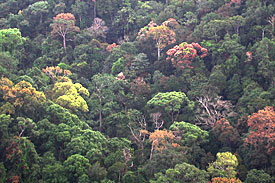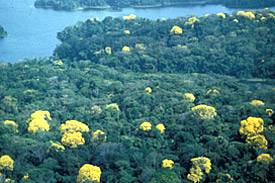Press release from February 15th, 2008
New method for measuring biodiversity
How individual species help structure the biodiversity of tropical rainforests
Leipzig. German and Sri Lankan researchers have developed a new method for measuring the impacts of species on local biodiversity. It makes it possible to determine whether a certain species promotes or suppresses species diversity. The new method extends a procedure familiar to biologists that involves investigating species numbers in relation to area (the species-area relationship, or SAR), by adding sophisticated statistical methods so that it can be used to describe the role of individual species in their impact on biodiversity.

Shorea trapezifolia in bloom. S. trapezifolia is one of the most dominant canopy
species preferring well drained middle and lower hill -slope habitats. It is one of the annually flowering Shorea species
which co-occurs with mast-flowering Shoreas. S. congestiflora, an annually flowering species is more dominant at lower
altitudes than at Sinharaja - a vicariant of S. trapezifolia.
Source: Nimal Gunatilleke, Universität Peradeniya

Luftaufnahme des Tropenwaldes auf Barro Colorado Island (BCI) in Panama. Im Foto sind die gelb blühende Guayacanbäume (Tabebuia guayacan) gut zu erkennen.
Source: Smithsonian Tropical Research Institute, Center for Tropical Forest Science
This individualised method (‘individual species-area relationship’, or ISAR) makes it easier to identify key species. "We are effectively looking at diversity in the ecosystem through the glasses of the individual species," says co-author Dr Andreas Huth of the UFZ. This means that in future it will be easier to understand the role of individual species in ecosystems and to implement targeted protection measures for key species. In addition, the method can be used to investigate better the ecological consequences of changes in land use.
The researchers used their new method to evaluate unique data from two tropical rainforests in Sri Lanka and Panama that are part of a network coordinated by the Center for Tropical Forest Science (CTFS; www.ctfs.si.edu). Within this network, every single tree with a trunk thicker than a pencil has been mapped and monitored for years on about a dozen selected sample plots, some as large as 50 hectares, in tropical rainforests around the globe. The researchers compared in their study around 40 000 larger trees in the tropical rainforest on Barro Colorado Island, Panama, with those in the Sinharaja World Heritage Site in Sri Lanka. To their surprise, more than two third of all species did not leave identifiable signatures on spatial diversity. The other tree species had an impact on local biodiversity only in their immediate surroundings, within a radius of up to 20 metres, but not on a large scale. These findings support the much-debated ‘neutral theory’, according to which species characteristics are unimportant for certain community attributes and play only a subsidiary role in the stability and diversity of ecosystems. The study reveals that the two tropical forests lacked any key species structuring species diversity at larger scales, suggesting that ‘balanced’ species–species interactions may be a characteristic of these species rich forests. Dr Thorsten Wiegand says, "Biodiversity researchers have not been able to agree on which processes permit a high level of species diversity to emerge, and which processes keep these complicated systems stable".
On the research plot in Panama there were lots of ‘repellent’ species. By contrast, the one in Sri Lanka is dominated by ‘attractor’ species, i.e. species that promote biodiversity. "It is not yet known why these two tropical rainforests are so different in this regard" say Savitri Gunatilleke and her husband Nimal, both professors at the University of Peradeniya, "but our method is a leap forward in an understanding of the complexities of the origin and maintenance of species richness in tropical forests". After all, the method was being used for the first time. "We first used the new method in tropical rainforests, but it is universally applicable and can be used for plants in all ecosystems," says Dr Andreas Huth of the UFZ. The new method closes a gap between rather more crude descriptions of biodiversity (for the whole ecosystem) and extremely detailed analyses (interactions between individual species). In future then, the new method can also be combined with the forest simulation models already developed at the UFZ.
Publication:
Thorsten Wiegand, C. V. Savitri Gunatilleke, I. A. U. Nimal Gunatilleke, and Andreas Huth: How individual species structure diversity in tropical forests.
PNAS, 10.1073/pnas.0705621104 ( Ecology )
Abstract "How individual species structure diversity in tropical forests"
Publication "How individual species structure diversity in tropical forests"
Links:
Press release from September 25th, 2007 (Species associations in a heterogeneous Sri Lankan Dipterocarp forest)
Species associations in a heterogeneous Sri Lankan Dipterocarp forest
Monitoring program of the Center for Tropical Forest Science (CTFS):
www.ctfs.si.edu/doc/plots/sinharaja/index.html
www.ctfs.si.edu/doc/plots/bci/index.html
More information:
Helmholtz Centre for Environmental Research (UFZ)
Dr. Andreas Huth
phone +49 341 235-1719
Dr. Andreas Huth
and
Dr. Thorsten Wiegand
phone +49 341 235-1714
Dr. Thorsten Wiegand
or
Helmholtz Centre for Environmental Research (UFZ)
Press office
Tilo Arnhold / Doris Böhme
phone +49 (0)341 235 2278
presse@ufz.de
Das Helmholtz-Zentrum für Umweltforschung - UFZ wurde 1991 gegründet und beschäftigt an den Standorten Leipzig, Halle/S. und Magdeburg rund 800 Mitarbeiter. Es erforscht die komplexen Wechselwirkungen zwischen Mensch und Umwelt in genutzten und gestörten Landschaften, insbesondere dicht besiedelten städtischen und industriellen Ballungsräumen sowie naturnahen Landschaften. Die Wissenschaftler des UFZ entwickeln Konzepte und Verfahren, die helfen sollen, die natürlichen Lebensgrundlagen für nachfolgende Generationen zu sichern.
Die Helmholtz-Gemeinschaft leistet Beiträge zur Lösung großer und drängender Fragen von Gesellschaft, Wissenschaft und Wirtschaft durch wissenschaftliche Spitzenleistungen in sechs Forschungsbereichen: Energie, Erde und Umwelt, Gesundheit, Schlüsseltechnologien, Struktur der Materie, Verkehr und Weltraum. Die Helmholtz-Gemeinschaft ist mit 25.700 Mitarbeiterinnen und Mitarbeitern in 15 Forschungszentren und einem Jahresbudget von rund 2,3 Milliarden Euro die größte Wissenschaftsorganisation Deutschlands. Ihre Arbeit steht in der Tradition des großen Naturforschers Hermann von Helmholtz (1821-1894).
